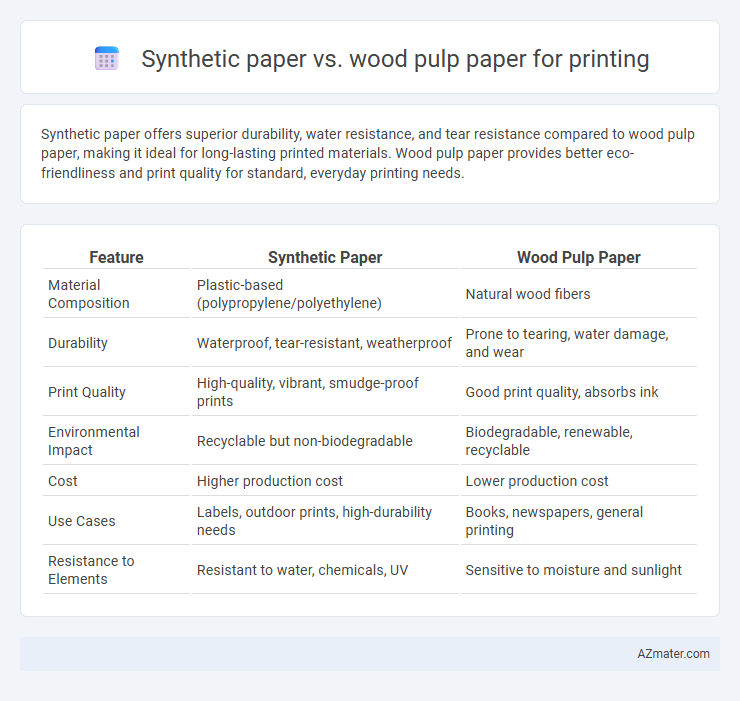Synthetic paper offers superior durability, water resistance, and tear resistance compared to wood pulp paper, making it ideal for long-lasting printed materials. Wood pulp paper provides better eco-friendliness and print quality for standard, everyday printing needs.
Table of Comparison
| Feature | Synthetic Paper | Wood Pulp Paper |
|---|---|---|
| Material Composition | Plastic-based (polypropylene/polyethylene) | Natural wood fibers |
| Durability | Waterproof, tear-resistant, weatherproof | Prone to tearing, water damage, and wear |
| Print Quality | High-quality, vibrant, smudge-proof prints | Good print quality, absorbs ink |
| Environmental Impact | Recyclable but non-biodegradable | Biodegradable, renewable, recyclable |
| Cost | Higher production cost | Lower production cost |
| Use Cases | Labels, outdoor prints, high-durability needs | Books, newspapers, general printing |
| Resistance to Elements | Resistant to water, chemicals, UV | Sensitive to moisture and sunlight |
Introduction: Understanding Synthetic and Wood Pulp Papers
Synthetic paper, crafted from plastic resins such as polypropylene, offers superior tear resistance, water durability, and chemical stability compared to traditional wood pulp paper. Wood pulp paper, derived from cellulose fibers of trees, is biodegradable and widely used in standard printing due to its natural texture and cost-effectiveness. Understanding the fundamental differences in composition and physical properties is essential for selecting the appropriate paper type for various printing applications.
Composition and Manufacturing Processes
Synthetic paper is composed primarily of polypropylene or polyethylene resins combined with fillers, produced through extrusion and calendaring processes that create a smooth, durable, and water-resistant surface ideal for printing. Wood pulp paper is derived from cellulose fibers extracted from trees, processed using mechanical or chemical pulping methods, then formed, pressed, and dried, resulting in a porous, absorbent substrate suited for traditional ink adhesion. The manufacturing differences lead to synthetic paper's superior tear resistance and moisture durability compared to wood pulp paper's natural biodegradability and texture variations.
Durability and Longevity Comparison
Synthetic paper offers superior durability and longevity compared to wood pulp paper due to its resistance to water, tearing, and fading, making it ideal for long-term printing applications. Unlike wood pulp paper, which deteriorates quickly when exposed to moisture and environmental factors, synthetic paper maintains its structural integrity and print quality over time. This enhanced durability reduces the need for frequent replacements, providing cost-effective solutions in environments demanding robust printed materials.
Print Quality and Color Reproduction
Synthetic paper offers superior print quality and vibrant color reproduction compared to wood pulp paper due to its smooth, non-porous surface that prevents ink bleed and enhances sharpness. Ink sits on the surface of synthetic paper, resulting in brighter, more saturated colors and improved detail accuracy for high-resolution prints. Wood pulp paper absorbs ink, which can cause colors to appear duller and less crisp, especially in detailed or color-critical printing applications.
Environmental Impact and Sustainability
Synthetic paper, made from polypropylene or high-density polyethylene, offers enhanced durability and water resistance compared to wood pulp paper but poses challenges in biodegradability and recycling, leading to concerns over long-term environmental impact. Wood pulp paper, derived from renewable forests, supports biodegradability and ease of recycling, yet its production can contribute to deforestation and higher water and energy consumption unless sourced from certified sustainable forests. Choosing wood pulp paper from FSC-certified suppliers promotes sustainability, while advances in synthetic paper recycling technologies aim to reduce plastic waste in printing applications.
Cost Analysis: Upfront and Long-Term Expenses
Synthetic paper typically has a higher upfront cost compared to wood pulp paper due to its specialized materials and manufacturing process. Over the long term, synthetic paper can offer cost savings through durability and resistance to tearing, water, and chemicals, reducing replacement and waste expenses. Wood pulp paper is generally cheaper initially but may incur higher costs over time due to less durability and greater susceptibility to environmental damage in printing applications.
Applications and Best Use Cases
Synthetic paper offers superior durability, water resistance, and tear-proof properties, making it ideal for outdoor labels, maps, and packaging that require longevity under harsh conditions. Wood pulp paper excels in cost-effectiveness, print quality, and recyclability, proving best for everyday printing tasks such as books, brochures, and office documents. Selecting between synthetic and wood pulp paper depends on specific applications, balancing durability needs with budget and environmental considerations.
Water and Tear Resistance Features
Synthetic paper offers superior water resistance compared to wood pulp paper, making it ideal for environments where moisture exposure is common. Its tear resistance is significantly higher due to its durable plastic composition, reducing waste and maintaining print integrity. Wood pulp paper, while biodegradable, tends to absorb water and tear more easily under stress, limiting its use in applications requiring durability.
Recyclability and Waste Management
Synthetic paper, made from plastic resins like polypropylene, offers excellent durability and water resistance but presents challenges in traditional paper recycling streams due to its non-biodegradable nature. Wood pulp paper, derived from natural fibers, is widely recyclable through standard paper mills and decomposes more efficiently in landfill or compost environments. Effective waste management favors wood pulp paper for sustainable recycling processes, while synthetic paper requires specialized recycling facilities or alternative waste strategies to minimize environmental impact.
Future Trends in Printing Paper Technologies
Synthetic paper offers superior durability, water resistance, and tear-proof qualities compared to traditional wood pulp paper, making it increasingly favored in high-performance printing applications. Innovations in biodegradable synthetic fibers and eco-friendly production methods are driving future trends toward sustainable printing solutions that reduce environmental impact. Advances in nanotechnology and smart coating integration are expected to enhance print quality and functional properties, positioning synthetic paper as a key material in next-generation printing technologies.

Infographic: Synthetic paper vs Wood pulp paper for Printing
 azmater.com
azmater.com